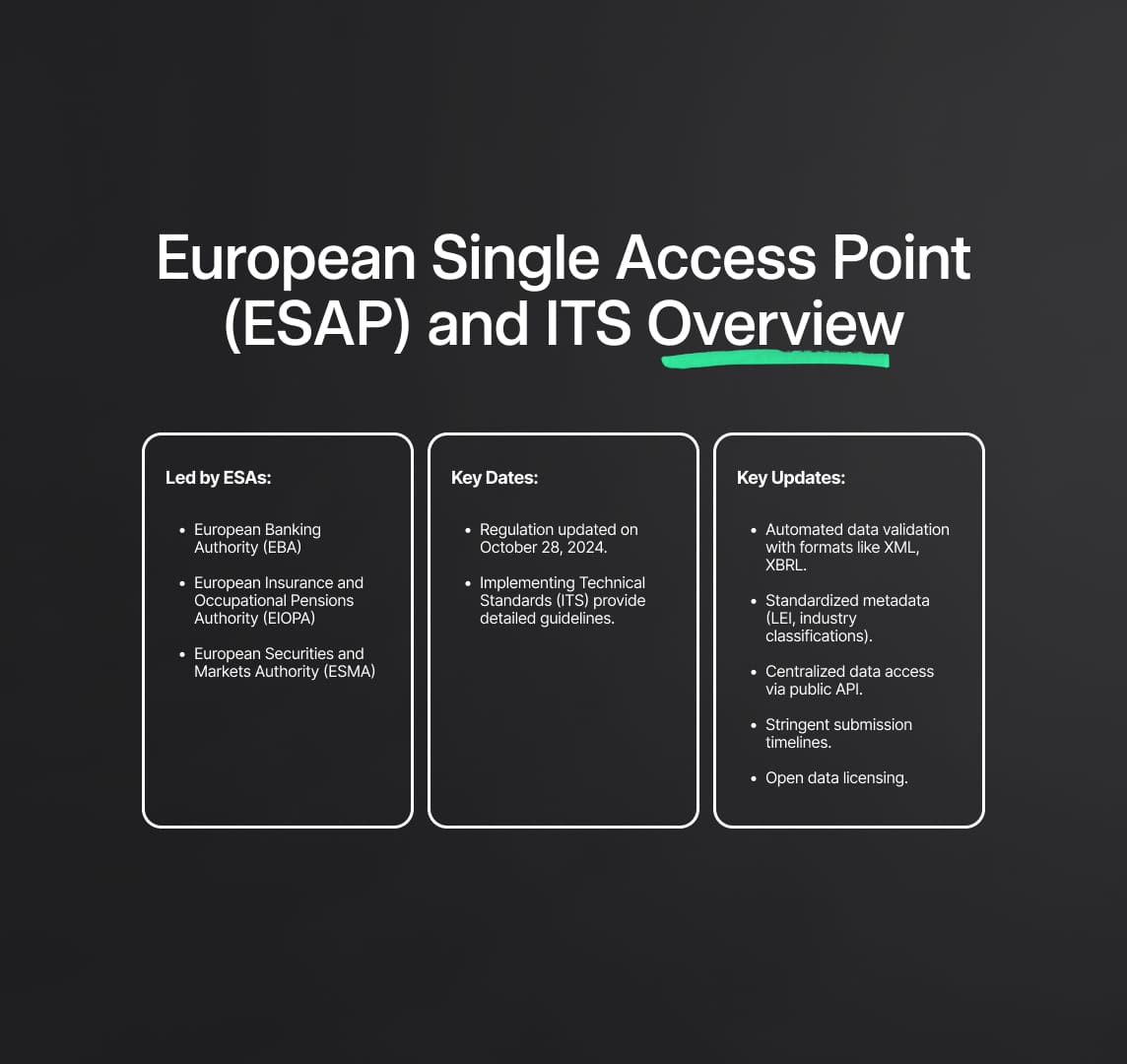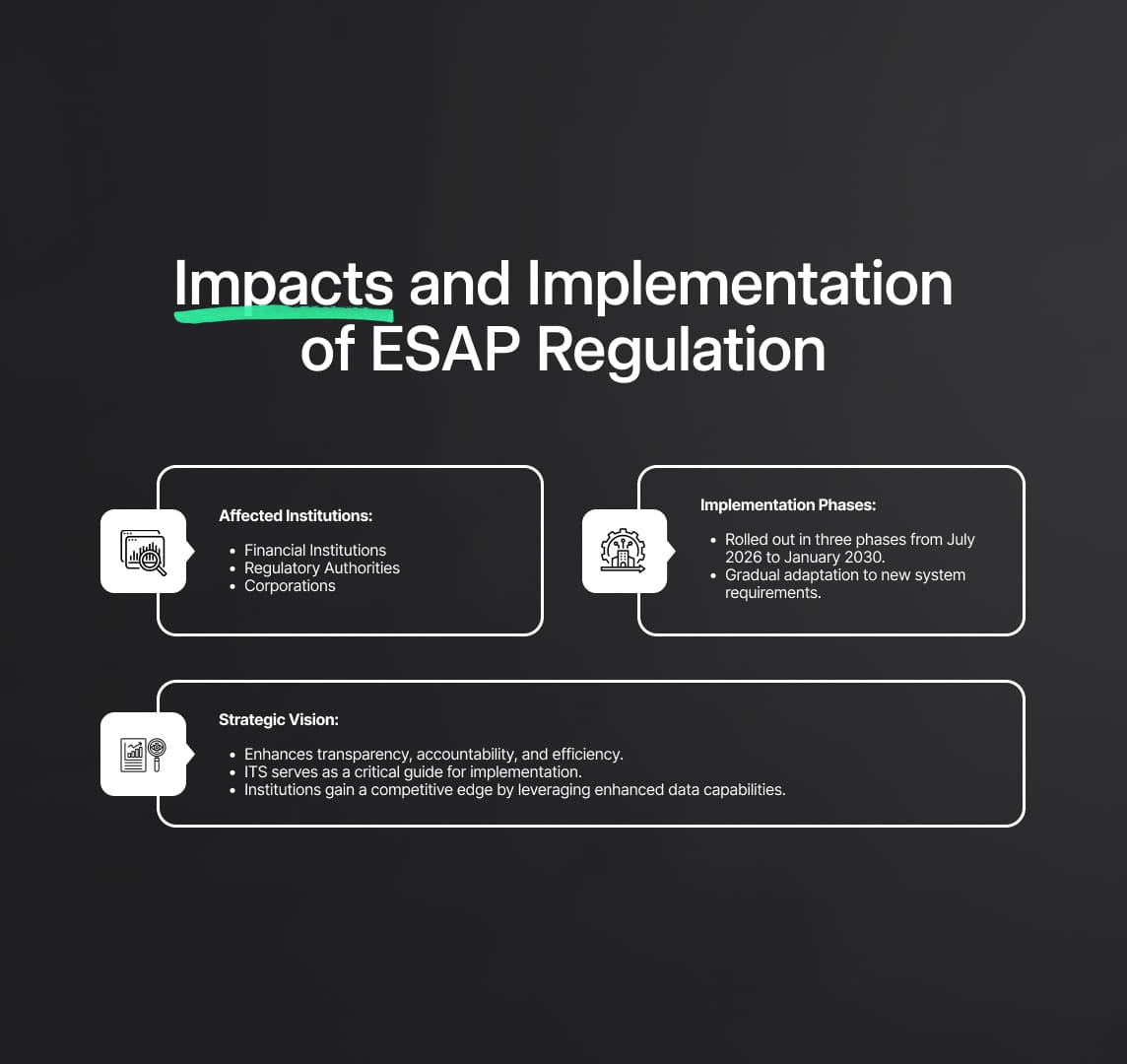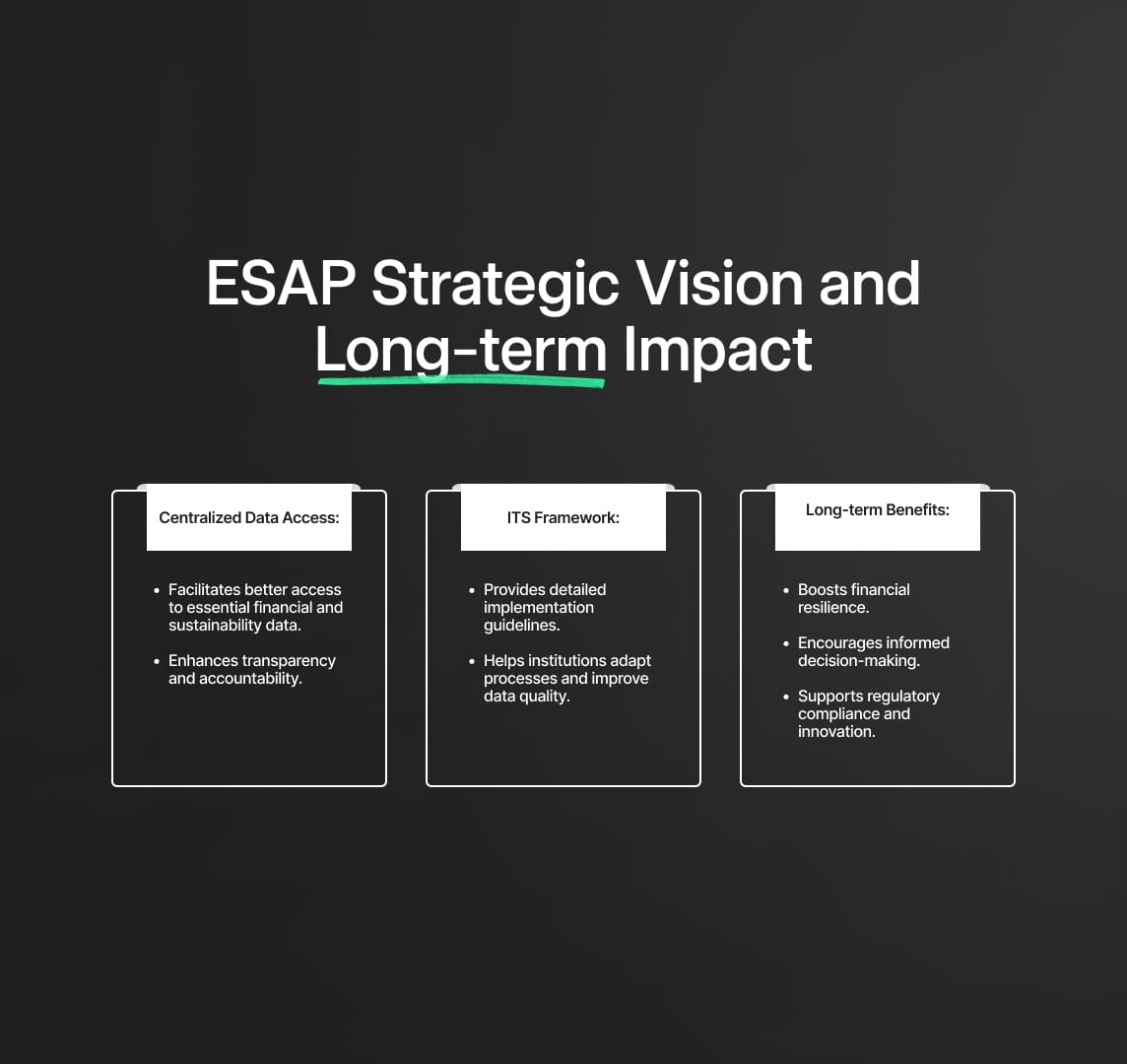European Single Access Point (ESAP): ESA Final Report on Draft ITS
ESAs introduce the European Single Access Point (ESAP) with ITS to streamline data reporting, enhance transparency, and improve financial resilience across the EU.

The European Single Access Point (ESAP) regulation, established under Regulation (EU) 2023/2859, represents a significant step towards creating a centralized platform for financial and sustainability information across the European Union. This initiative, led by the European Supervisory Authorities (ESAs)—namely the European Banking Authority (EBA), the European Insurance and Occupational Pensions Authority (EIOPA), and the European Securities and Markets Authority (ESMA)—aims to enhance transparency, streamline reporting, and facilitate better access to essential data for stakeholders.
The regulation was officially updated on October 28, 2024, with the release of the Implementing Technical Standards (ITS). These ITS documents are crucial as they provide detailed specifications and guidelines for how the ESAP system will function, including the responsibilities of collection bodies and the technical requirements for data submission.

Source
[1]

Who Will be Impacted by the ESAP Regulation?
Affected Institutions:
- Financial Institutions: These include banks, investment firms, and insurance companies, which are required to disclose detailed financial and sustainability data.
- Regulatory Authorities: National and EU-level regulatory bodies will oversee data collection and ensure compliance with the new standards.
- Corporations: Especially publicly listed companies, are mandated to submit information related to financial performance and sustainability metrics.
Impact on Institutions:
The ITS mandates these institutions to adhere to new processes and standards for data reporting. This includes using specific data formats, meeting stringent submission timelines, and ensuring the security and integrity of their submissions through qualified electronic seals. These standards are designed to ensure consistency, accuracy, and transparency in the data available on the ESAP platform.
What Are the Key Updates in the ESAP Regulation and Their Impacts?
The ESAP regulation introduces a series of updates designed to revolutionize the handling of financial and sustainability information. The ITS plays a pivotal role in operationalizing these updates, providing the technical framework necessary for implementation. This section delves into the key regulatory provisions and their long-term implications.
1. Automated Data Validation
One of the cornerstone updates in the ESAP regulation is the requirement for collection bodies to implement automated data validations. This entails:
- Ensuring Data Extractability and Machine Readability: All submitted information must be in formats such as XML, XBRL, or Inline XBRL, which facilitate automated processing and validation.
- Qualified Electronic Seals (QES): Data submissions must be accompanied by a QES to guarantee the authenticity and integrity of the information.
The ITS provides precise guidelines on how collection bodies should perform these validations, detailing the acceptable formats and the specific checks required to ensure data quality. These standards ensure that data submissions are both consistent and secure, reducing the risk of errors and enhancing the overall reliability of the ESAP platform.
Financial institutions and corporations will need to overhaul their data submission systems to support automated validations and the use of QES. The ITS helps institutions by clearly defining the validation processes and the criteria for compliance. This shift will lead to enhanced data integrity and reliability, reducing the manual effort involved in data verification and mitigating the risk of errors.
Automated validations, as detailed in the ITS, will establish a new standard for data quality. Institutions will benefit from streamlined compliance processes and faster reporting cycles, ultimately leading to more informed decision-making across the financial sector.
2. Standardization of Metadata
The regulation mandates the use of standardized metadata, which includes key elements such as Legal Entity Identifiers (LEI), industry classifications, and size categories of reporting entities.
The ITS outlines the exact metadata requirements, specifying the formats, structures, and elements that must be included in all submissions. This ensures that all data submitted to the ESAP is standardized, facilitating easier access and analysis.
This standardization will improve the consistency and interoperability of data across different platforms and jurisdictions. Institutions must ensure that their data reporting systems can capture and transmit the required metadata accurately. The ITS simplifies the implementation process by providing clear, detailed instructions on metadata formatting and submission.
The use of standardized metadata, as mandated by the ITS, will simplify data aggregation and analysis, making it easier for regulators, investors, and other stakeholders to access and interpret financial and sustainability information. This will enhance transparency and accountability, paving the way for more robust financial oversight.
3. Centralized Data Access via Public API
The ESAP regulation emphasizes the development of a public API to provide centralized access to financial and sustainability information. The API will allow users to:
- Search for Information: Users can query the ESAP database using various metadata filters.
- Download Data: Information will be available in multiple formats, including CSV, Excel, and PDF, catering to diverse user needs.
The ITS specifies the technical requirements for the API, including data formats, security protocols, and user access controls. These guidelines ensure that the API is robust, secure, and user-friendly, promoting widespread use and accessibility.
The public API will democratize access to financial and sustainability data, enabling a wider range of users—from analysts to the general public—to engage with the information. Institutions must ensure their data submissions are compatible with the API’s requirements to facilitate seamless data access.
This centralized access will enhance transparency and foster greater engagement with financial and sustainability data. It is expected to drive innovation in data analysis and reporting, as well as support more informed investment and policy decisions.
4. Stringent Timelines for Data Submission
Under the new regulation, collection bodies must adhere to strict timelines, with a maximum delay of 60 minutes allowed for data validation and submission to the ESAP platform after receipt.
The ITS provides clear guidelines on the timing of data submissions, specifying the steps collection bodies must take to validate and forward data promptly. This ensures a consistent and efficient flow of information into the ESAP.
Institutions will need to optimize their data processing workflows to comply with these tight deadlines. This may involve investing in real-time data processing technologies and enhancing internal coordination to ensure timely submissions. The ITS helps institutions navigate these requirements by providing a structured timeline and operational framework.
The introduction of stringent timelines will ensure that the ESAP platform remains an up-to-date source of financial and sustainability information. This will enhance the platform’s reliability and usefulness for stakeholders who rely on timely data for decision-making.
5. Open Data Licensing
The regulation promotes the use of open data licensing, requiring the adoption of Creative Commons licenses (CC0) for non-copyrighted data and BY-NC-ND licenses for copyrighted content.
The ITS clarifies the conditions under which different types of data can be shared and reused, ensuring that institutions adhere to consistent licensing standards. This supports the broader goals of transparency and accessibility, enabling data to be used more freely across various applications.
This licensing framework will encourage the reuse of data for research, innovation, and regulatory purposes. Institutions must ensure they understand and comply with these licensing requirements to avoid legal issues and facilitate broader data sharing.
Open data licensing, as framed by the ITS, will foster a culture of transparency and collaboration. It will enable new opportunities for data-driven innovation and research and support the development of new tools and applications that leverage the vast amounts of financial and sustainability data available through ESAP.
6. Phase-wise Implementation
The ESAP system will be rolled out in three phases, beginning in July 2026 and culminating in January 2030. Each phase will introduce new types of information and expand the system’s capabilities.
The ITS provides a phased roadmap for implementation, detailing the specific requirements and timelines for each phase. This approach ensures that institutions can gradually adapt to the new system, minimizing disruption and facilitating a smooth transition.
Institutions will need to prepare for each phase by aligning their data reporting practices with the evolving requirements. The ITS allows for a gradual and structured transition, enabling institutions to meet compliance deadlines without overwhelming operational changes.
The phased implementation will ensure a smooth transition to the new reporting framework, allowing institutions to progressively enhance their capabilities and compliance. This approach will also provide valuable insights into the system’s performance and inform future enhancements.

ESAP Strategic Vision
The ESAP regulation marks a significant milestone in the evolution of financial and sustainability reporting in the European Union. By centralizing access to critical data and standardizing reporting practices, ESAP is poised to enhance transparency, accountability, and efficiency across the financial sector.
In the long run, ESAP is expected to become an indispensable tool for regulators, investors, and other stakeholders. Institutions that invest in the necessary technological and process upgrades will not only ensure compliance but also gain a competitive edge by leveraging enhanced data capabilities.
The ITS is central to this transformation, offering a clear and detailed framework for implementation. As institutions navigate the phased rollout, the ITS will serve as a critical guide, helping them adapt their processes, enhance data quality, and foster transparency.

Reduce your
compliance risks

